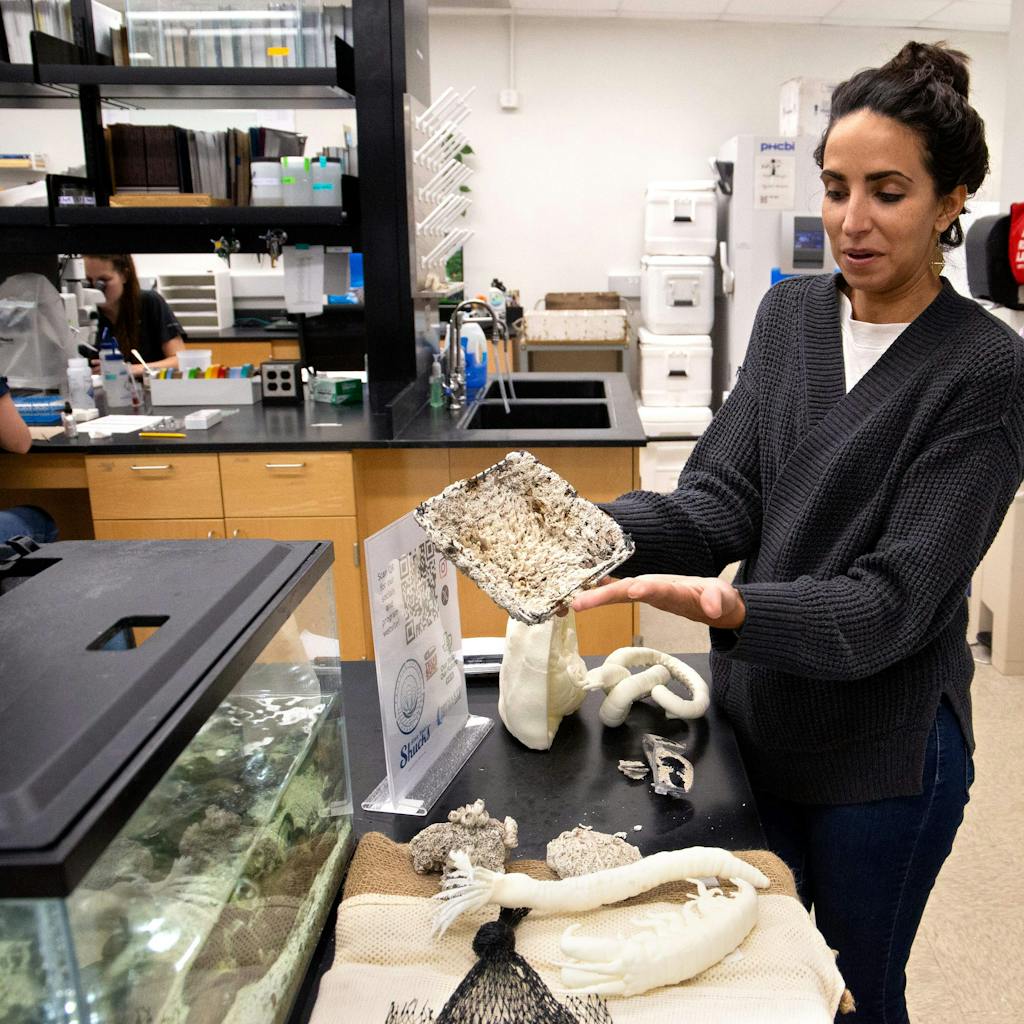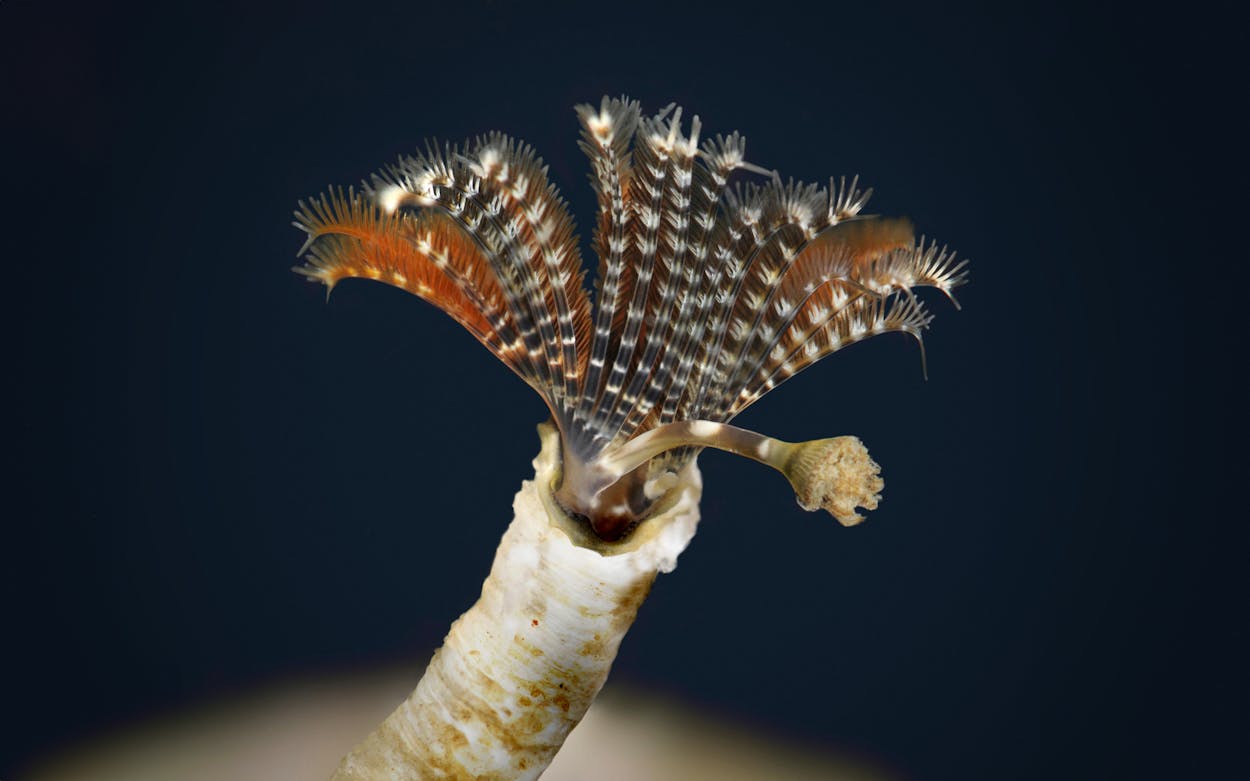The fish are always biting in Baffin Bay, a one-hundred-square-mile body of water that cuts in toward the South Texas Plains about two hours south of Corpus Christi. The bay is home to redfish and speckled trout, prized sport fish that beckon anglers nationwide. It’s also known as a great spot to catch black drum. Roughly half of all black drum caught in the Upper Laguna Madre, the vast saltwater lagoon that separates the mainland from Padre Island, comes from Baffin. This abundance would appear to be at odds with the bay’s extreme salinity: salt levels here can rise to one hundred parts per thousand, three times that of the Gulf of Mexico. But this is no Dead Sea. For more than a century, Texans have marveled at the bay’s prolific output, and for much of that time, nobody had reason to think too hard over it.
Reason came in the summer of 2012, when anglers began to catch emaciated black drum with gelatinous flesh, a mysterious condition that stunted thousands of fish. The affliction was so severe and widespread that commercial fish buyers refused entire hauls, putting an industry in jeopardy. In short order a coalition of anglers, state agencies, and marine scientists formed to investigate. They found that a brutal drought and high summer temperatures had likely caused Baffin’s salt levels to rise to deadly levels, overstressing the drum’s gills until the fish ran out of energy, parboiling in the water. While studying this, researchers stumbled across something unexpected: they discovered that another denizen of the bay, a rare marine worm found hardly anywhere else on the planet, may hold the key to preserving this fragile, one-of-a-kind ecosystem.
This isn’t the kind of worm you’ll find squirming in your garden, but an underwater variety you’ve probably never heard of. Serpulid worms are filter feeders that use a crown of feathery tentacles to snare food particles suspended in the water. They build calcium carbonate tubes and hide in them, their exposed palps swaying with the tide in vibrant shades of orange, pink, red and yellow. Serpulid worms can create colonies of hundreds of millions; to a casual observer, these colorful colonies look like fields of flowers in bloom. The spent tubes function similarly to coral reefs, attracting other invertebrates and predators and facilitating a healthy ecosystem. Serpulid reefs were once common along coastal waters of North America, filling an important ecological niche in areas too shallow and salty for coral reefs. Now these reefs have all but vanished worldwide due to urban sprawl, rising sea levels, drought, and collisions with watercraft. Almost all of the few that remain are fossilized, no longer containing living worms. Active reefs can now be found only in Scotland and the United States. And the last active reef standing on the Gulf Coast is in Baffin Bay.

But even this reef is struggling, says Tasha Breaux, who manages the serpulid reef research at the Harte Research Institute in Corpus Christi. Large sections of the reef have already been reduced to rubble, she says. That’s partially due to the bay’s poor water quality: researchers have identified a handful of wastewater treatment plants discharging into the bay and loading it with nitrogen. The wastewater acts like a fertilizer, causing algal blooms that steal oxygen from fish and worms alike. Drought can take a toll on the worms, too, but not in the same way it affects fish. As high temperatures and a lack of rainfall cause evaporation in the bay, the water gradually becomes more acidic. In the right conditions, the bay becomes an acid bath for serpulid worms, literally dissolving their calcium carbonate tubes in place. “[The reefs] seem to be shrinking. Crumbling and shrinking. And we really don’t know the extent,” Breaux says.
She and her colleagues still have much to learn about this obscure species. Serpulid worms were first observed building reefs in Baffin Bay from 1875 to 1910, but no more activity was described until the early 1970s, when researchers sought to study the bay in more detail. Even still, the reef was considered to be mostly dead and unworthy of serious scientific inquiry—only in the past five years have scientists begun to grasp the outsize role serpulid worms play in this ecosystem. “We’ve been doing a lot of work to learn more about them, because they just haven’t been studied a whole lot,” Breaux says. “In Baffin it’s too salty for oysters. It’s too salty for a lot of things. So they take up this unique ecological niche.” Serpulid reefs have been discovered in similar environments, such as Santa Monica Bay and Tampa Bay, but none contained living worms, stymying efforts to study them further. Now researchers suspect that the serpulid reefs in Baffin Bay are almost solely responsible for attracting prey species, such as mollusks and crustaceans. Those critters are vital food sources for redfish, trout, and black drum. In the bay’s muddy bottom, where the reef is absent, sediments contain virtually no life. “When you compare this abundance to the bare sediments, it’s incredible. We’re talking hundreds of times more in the reefs,” Breaux says.

So the fish in Baffin Bay depend on the serpulid reefs. In hindsight, this should have been obvious. After all, what do you use to catch a fish? A worm. But what do you use to catch a worm? For that, you need a team of marine biologists aboard a 24-foot aluminum work boat with an outboard motor. On a quarterly basis, the Harte team motors out to the reef to chisel off a few samples. The serpulid colonies are most prevalent at the mouth of the bay, where they ring the shoreline at irregular intervals and hide just under the slow, chest-high churn from the Laguna Madre. The scientists undertake the surprisingly simple and straightforward task of sample collection—whacking the reef with a hammer—while taking care not to do further damage by hitting it with their boat. (In deeper areas, the researchers snorkel over the reef to collect samples; in other spots they stand in ankle-deep water.) Over the years plenty of anglers have unwittingly encountered the reef, later blaming a dinged outboard motor or cracked fiberglass hull on the craggy boulders that they didn’t know were actually colonies of worms.
The Harte folks jar the samples and head back to the Texas A&M–Corpus Christi campus, where from a bayside laboratory they delve into the world of this strange and rare polychaete worm. They spend long, eye-blearing hours peering through microscopes and turning the pages of dusty old reference books detailing the anatomies of marine invertebrates. Only one of the 350 species of family Serpulidae is found in Baffin Bay, Hydroides dianthus.
On a weekday in early December, research specialist Danielle Downey uses tweezers to sift through a reef sample collected two days prior. Downey submerged the sample in hydrochloric acid beforehand to dissolve the worms’ calcium carbonate tubes. With those out of the way, she can separate the other little critters that live in the reef, such as bivalves, gastropods, and crustaceans, from inorganic matter. Downey then weighs the pieces and logs the data. The most common reef visitors are amphipods, miniature trash-eaters that subsist on decaying matter and measure mere millimeters. “In a tiny chunk of reef, you’ll find a thousand, three thousand of them,” Breaux says.
A few pet worms wave their tentacles inside a small fish tank in the middle of the room, where they’ve set about creating a microcosm of a serpulid reef. You can see a worm living inside the lip of an oyster shell, its white feathery crown combing the water for lunch. A crab, a sea anemone, and other bottom-dwellers keep it company. But as an onlooker approaches, the worm ducks back into its tube. That figures: the serpulid worms of Baffin Bay, and their reefs, are still cloaked in mystery. The reefs are discontiguous, difficult to see, and have yet to be properly mapped. The worms can be reclusive even in the sections of reefs that have been well researched. “It can be a bit difficult to actually find the worms. The reef has been overtaken with so many other species that it’s not always easy to find the actual worms that build them,” Breaux says. At the workstation behind Downey’s, lab technician Zach Zagon’s eyes are glued to a microscope as he hunts for worms in a reef sample taken in October. “Here we have a big ol’ Lepidopa,” a sand crab, Zagon says. A cool find, but it’s no serpulid worm. He keeps looking.
It’s not all drudgery. The team has had success attracting serpulid worms to attach to man-made objects, such as large plastic trays and wire baskets. This raises the possibility of creating new sections of reef with a little human help, a tactic that’s been used in Texas to revitalize 66 coral reefs in the Gulf of Mexico. Breaux holds up a basket that’s been almost completely colonized by the worms. Much of the surface is covered in fresh tubes. “We pulled this up after three months and it had this much growth on it,” she says. “When you go to pick one of these up, every single one of these holes has something living in it. There’s something everywhere. . . . It spurs us along.” Pictures don’t always do it justice—a photo posted to the Institute’s Facebook page was confused for a chunk of unboiled ramen.
For that reason, the serpulid worm makes a poor mascot. It’ll never command the vast sympathetic audience of bottlenose dolphins or Kemp’s ridley sea turtles. But these unsung heroes of the Gulf Coast are content to work their magic behind the scenes. For now, Baffin’s black drum are doing swimmingly; they’ve hit the bay’s carrying capacity, or the maximum number that the waterway can support. In late winter the drum make spawning runs into the bay’s tributaries, and come spring, their young will start their own lives in Baffin Bay, the underwater land of plenty.






